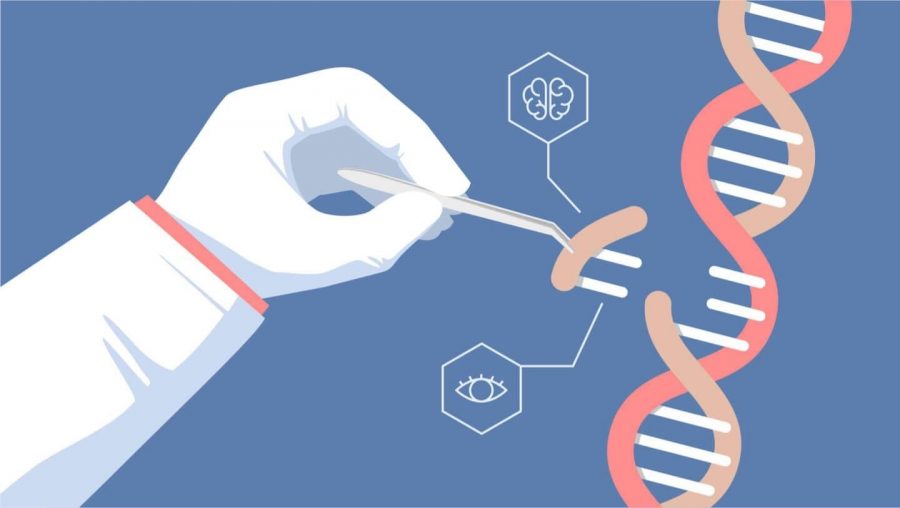CRISPR: The Tool that Can Transform Medicine and Humanity
December 18, 2019
Over the past few years, a new toy has appeared in the face of biology: CRISPR-Cas9. CRISPR stands for Clustered Regularly Spaced Palindromic Repeats and is a sequence of DNA found in prokaryotes, that helps them defend against viruses. Today, scientists refer to it as a system used for genome editing, i.e. changing one’s DNA. The most used form of CRISPR is called the CRISPR-Cas9, which uses the Cas9 protein to find and destroy specific parts of a DNA strand, thus deactivating a certain gene. It includes an RNA molecule (crRNA) which is used to escort the system to a specific part of the DNA strand. While other gene editing techniques have existed, CRISPR is the only technique that works in organisms such as mice and humans.
In the 1990s, scientists at the University of Alicante, Spain, discovered CRISPR when examining archaea. They then looked for it in bacteria and found it there as well. In 2012, Emmanuelle Charpentier and Jennifer Doudna discovered that CRISPR could be used for gene editing at U.C Berkeley and are the pioneers of this technology. Later, the Zhang lab at the Broad Institute applied CRISPR to human cells, but were awarded the patent first. According to a Questions and Answers article on the Broad Institute’s website, the Zhang lab “first engineered CRISPR to edit the genome in mouse and human cells”. Of course, scientists would ultimately like to use CRISPR to treat human illnesses, but they need to experiment on smaller organisms first. Additionally, in another article about the timeline of CRISPR research, the Zhang lab “showed that the system (i) could be programmed to target multiple genomic loci, and (ii) could drive homology-directed repair”. This is very important to the CRISPR system because it needs to target multiple locations on the DNA strand. Furthermore, after the DNA is cut, the strand needs to be repaired.
CRISPR might be the cure to many terrible diseases, but could it be exploited for unethical uses? Quite recently, biophysicist He Jiankui, used gene editing to create two babies, causing scientists all over the world to unite and create a global moratorium on using gene editing to manufacture children. The truth is that the world is not ready for scientists to interfere in the way nature makes life, and science isn’t prepared to face the consequences of CRISPR children.
A whole new perspective on gene editing is emerging. While some scientists are already experimenting at the frontiers of science, others are using CRISPR at a slower pace. In an article on Columbia University’s website, Dr. Samuel Sternberg talks about the difficulties in deploying CRISPR to solve genetic diseases. He says “controlling DNA repair is still a major bottleneck in developing gene editing for clinical applications” and adds “the way that the cut [DNA] is repaired is still very hard to predict and control.” CRISPR is used to cut DNA, but putting it back together can’t be controlled by scientists. To apply CRISPR to patients, the DNA needs to be both cut and repaired. However, this doesn’t mean that CRISPR can’t be used in patients, but it can only be used for illnesses where the DNA strands do not necessarily need to be repaired. Across many people, another fear grows — can people modify themselves to become stronger or change how they look? In the next few years, we will find out what future CRISPR brings us.
CRISPR technology is relatively new to biology and will continue to be perfected. Scientists will look to understand the ethical and societal dilemmas before applying it more broadly. Since Mendel and the discovery of the gene, scientists have developed our understanding of how genes work and we are now on the verge of curing some of the worst diseases, thanks to CRISPR.
References
“CRISPR Timeline.” Broad Institute, 7 Dec. 2018, https://www.broadinstitute.org/what-broad/areas-focus/project-spotlight/crispr-timeline.
“Do CRISPR Risks Outweigh Rewards?” GEN, 5 Nov. 2018, https://www.genengnews.com/magazine/328/do-crispr-risks-outweigh-rewards/.
Lander, Eric S., et al. “Adopt a Moratorium on Heritable Genome Editing.” Nature News, Nature Publishing Group, 13 Mar. 2019, https://www.nature.com/articles/d41586-019-00726-5.
“Questions and Answers about CRISPR.” Broad Institute, 4 Aug. 2018, https://www.broadinstitute.org/what-broad/areas-focus/project-spotlight/questions-and-answers-about-crispr.
“The CRISPR Revolution: What You Need to Know.” Columbia University Irving Medical Center, 4 Apr. 2019, https://www.cuimc.columbia.edu/news/crispr-revolution-what-you-need-know.
About the Author


